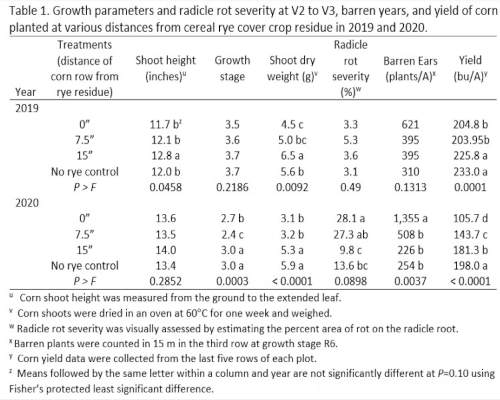Table 1 summarizes our results. In 2019, corn seedlings were shortest when corn was planted 0” from cereal rye residue and tallest when the corn was planted 15” from the cereal rye residue. Corn shoot height did not differ among the treatments in 2020. Corn seedlings were most vigorous (approximately half a growth stage ahead and heavier) in the no cover crop control and when corn was planted 15” from the cereal rye residue compared to the corn planted within the cereal rye residue. In general, seedling disease was low and did not differ among treatments in 2019. In 2020, however, disease was more severe in seedlings planted within the cereal rye residue and 7.5” from the cereal rye residue than seedlings planted following no cover crop or planted 15” from cereal rye residue. In 2020, more barren plants were observed in corn planted into cereal rye residue compared to the other treatments. In both years, corn yield generally decreased as corn was planted closer to cereal rye residue.

Table 1. Growth parameters and radicle rot severity at V2 to V3, barren years, and yield of corn planted at various distances from cereal rye cover crop residue in 2019 and 2020.
These data suggest that physically distancing the corn crop from the cereal rye cover crop is one way to reduce the negative effects of a winter rye cover crop on corn. As precision planting becomes more common on Iowa farms, it is possible farmers could deliberately seed a winter cereal rye cover crop in the interrows to physically separate the cereal rye from the corn rows planted the following season. Note however, in this study we did not investigate the effects of social distancing corn from cereal rye residue on the ecological services that a rye cover crop provides. A primary reason for growing cover crops is to protect soil and improve water quality. Other reasons include weed management and improving soil health. Since less ground is covered when a single row of cereal rye is seeded in 30-inch rows, there is more bare ground that may be subject to erosion, reduced infiltration and weed establishment. Moreover, the cereal cover crop may capture less nitrate, resulting in more leaching and reduced improvement in water quality. Further studies to understand the effects of winter cereal rye spacing arrangements on erosion, water quality, and weed control are needed.
Source : iastate.edu